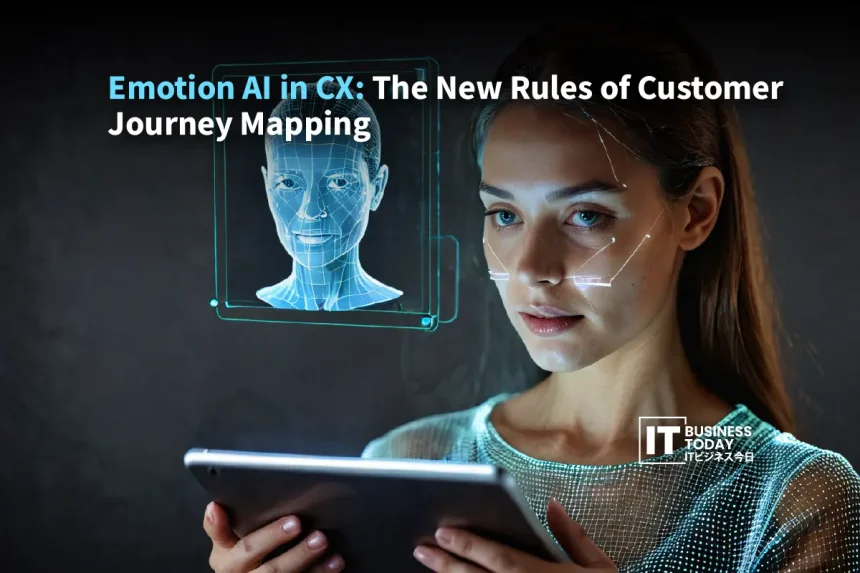What if every customer journey map you’ve relied on so far was only telling half the story? Most maps track what a customer does and rely on survey scores like NPS or CSAT. They show steps and numbers, but they do not show what the customer feels or why they make certain choices.
This is where Emotion AI changes everything. Also referred to as affective computing, it applies AI to recognize and elucidate human feelings through various signals. It has the capacity to analyze written communication, speech, and even visual expressions in order to grasp actual emotions during the interaction.
AI in CX transforms the classic two-dimensional, monotone representation into a dynamic, emotional habitat. It records positive and negative moments, as well as points of contention, instantly. Organizations are able to perceive not only the behaviors but also the emotions motivating those behaviors. This is the base of the new customer experience paradigm, where emotions drive insights, choices, and interactions that are smarter.
Also Read: Japan’s Retail Revolution: How Generative AI Is Rewriting Consumer Personalization
The CX Blind Spot and Why Traditional Maps Fail
Most customer journey maps we rely on today are incomplete. Surveys and basic analytics can only tell part of the story. Post-interaction surveys capture how a customer feels after the experience. But memories fade and people rate things based on the last interaction. A smooth checkout can hide frustration earlier. This is called recall bias or the halo effect. It makes your so-called pain points blurry.
Then there is the problem of data being in silos. Behavioral data like clicks, time on site, and transactions live in one system. Notes from support calls or chat logs sit somewhere else. When data does not talk to each other, you end up guessing emotions instead of understanding them.
The emotional delta is what really matters. Old-school methods just indicate whether a customer is happy, unhappy or neutral. They do not provide any information about the customer’s feelings like anxiety over shipping, confusion regarding a warranty or excitement over a new feature. Emotion AI picks up on these small differences and transforms vague pain points into clear and actionable insights.
For example, an abandoned cart may not just be friction. The customer could be anxious about shipping fees or confused about warranty options. Google Cloud highlights five big AI trends for 2025. Multimodal AI, AI agents moving beyond chatbots, AI-powered customer experiences, assistive search, and tighter security. These trends let companies go past static maps. They create a living view of customer emotions instead of a flat diagram.
If you do not recognize these blind spots, you are flying blind. Emotion and AI together make CX real, proactive, and human-centered.
Decoding Affective Computing and How Emotional AI Works

Emotional AI sounds fancy, but it is basically about reading human emotions and turning them into insights. The key is the input. You need the right channels to capture signals that show what a person feels. Text is the first obvious one. It is not just what words someone uses. It is how they use them. Capitalization, punctuation, repeated letters, intensity, and context all matter. A customer typing HELLO versus hello shows very different emotions.
Voice is another. How fast someone speaks, their pitch, tone, and stress tells you more than the words themselves. Two people can say the same sentence, but one is calm and the other frustrated. Prosody analysis helps AI tell the difference. It is subtle, but it changes how you respond.
Some systems can also look at micro-expressions on video or camera feeds. It is less common, but in some retail or UX testing situations, facial cues can reveal emotions like confusion, excitement, or anxiety.
The bigger change comes in how data is used. Traditional metrics like NPS scores or first call resolution numbers tell you what happened. They do not tell you why. Emotional AI moves from just counting numbers to giving prescriptive insights. It can flag the exact moment a customer gets frustrated or confused. It can suggest what action to take next.
Microsoft has been pushing this hard. New AI tools have been introduced which are making it easier for software developers to build, customize, and manage AI apps and agents. More than 70,000 businesses have started utilizing the tools already. This is indeed a significant acceptance in the real world. It is an evidence that AI is not merely an idea. It is in fact, giving active assistance to the companies in understanding their customers better and also, responding at their convenience.
To sum it up, affective computing makes emotions visible and manageable instead of concealed and chaotic. It is the driving force behind a more intelligent and understanding customer service experience.
Rule Set 1. Mapping the Dynamic Emotional Pathway
Customer journey maps have been static for too long. They show steps and actions but nothing about how the customer actually feels at each step. Emotional AI in CX changes that. The first new rule is to stop looking at touchpoints and start tracking emotional channels. You are not just mapping clicks, calls, or purchases anymore. You are mapping feelings. The emotional curve shows when someone is excited, confused, anxious, or frustrated.
This means finding emotional friction points, not just transactional pain points. For example, a customer calling support with high anxiety should be escalated immediately, even if their ticket history looks fine. That anxiety matters more than the number of past calls. AI can spot these patterns in real time and alert the team to act.
The second rule is hyper-personalization beyond purchase history. It is no longer enough to know what a customer bought last month. You must understand their emotions at this moment. In case the AI identifies a user’s displeasure during a conversational session, it will change the automatic reply from selling a product to offering compassionate assistance. If the customer shows signs of being excited or passionate about something, the AI can propose a gentle upsell or invite the customer to be a supporter of your brand. The personalization turns into emotional, not just transactional.
The third rule is dynamic journey orchestration. The map is no longer a static diagram on a wall. It becomes a living document that triggers adaptive responses automatically. AI moves from simply reporting what happened to predicting what will happen. It can forecast which customers are at risk of churning based on sustained negative emotional patterns. Teams can intervene before the customer leaves.
Adobe’s 2025 AI and Digital Trends report shows how generative and agentic AI are helping companies meet the demand for personalization. These tools allow teams to anticipate customer needs and deliver experiences that are tailored and measurable. The combination of emotional insight and AI-driven action is what makes the new map powerful.
This is how companies turn data into empathy, touchpoints into feelings, and static diagrams into predictive tools that guide real human-centered experiences.
Rule Set 2. From Reactive Fixes to Proactive Resolution
Most companies wait for problems to show up before reacting. That approach is slow and costly. AI in CX flips this model. It turns emotional insights into proactive action. When you can connect feelings to business metrics like first call resolution, churn, or average handling time, you can see exactly where to act.
Emotion AI also helps human agents on the front lines. It works like a real-time coach. If a customer’s frustration spikes during a call or chat, the system can alert the agent immediately. This reduces burnout and keeps quality high. Agents no longer guess what a frustrated customer needs, they know in the moment.
Emotion data does more than support teams. It feeds back into products. You can spot which features, articles, or processes create the most confusion or stress. That information drives product improvements before complaints pile up.
HubSpot emphasizes using AI for customer journey mapping. Their tools use machine learning to process large amounts of data, uncover patterns, and even predict future behaviors. This is exactly how companies move from fixing problems after they happen to preventing them in the first place. AI in CX becomes both a shield and a guide. You see issues early and act fast, making the entire customer experience smoother and smarter.
Building Trust and Transparency in Emotional AI

Trust is not optional when using emotional AI. Companies must be clear and upfront about collecting data like voice tone or facial expressions.
Customers should know exactly what is being captured and why. Bias is real. Algorithms can misread emotions across different groups, so continuous auditing is essential to stay fair. Ethical guardrails matter too.
AI should improve the experience, not manipulate behavior for profit. Statista shows that customer service chatbots are the most common form of generative AI in travel, showing how widely AI in CX is being adopted. Transparency builds trust and loyalty.
The Future of Empathetic CX
The effect of AI in CX is altering our perspective on customer journeys. A mapping which was previously a plain static design has evolved into a living and bustling map of sentiments and responses.
Organizations can now not only observe the actions of customers, but also know their feelings and moods at each point of the journey. This transforms customer experience into being both empathetic and predictive, giving companies the ability to intervene before the problems escalate.
By combining emotion with data, customer experience is no longer regarded as a process done on a massive scale but rather as a human-centered process. It is no longer a mere play of figures. It has turned into comprehending people, forecasting their needs, and behaving in a way that is natural, personal, and meaningful.







